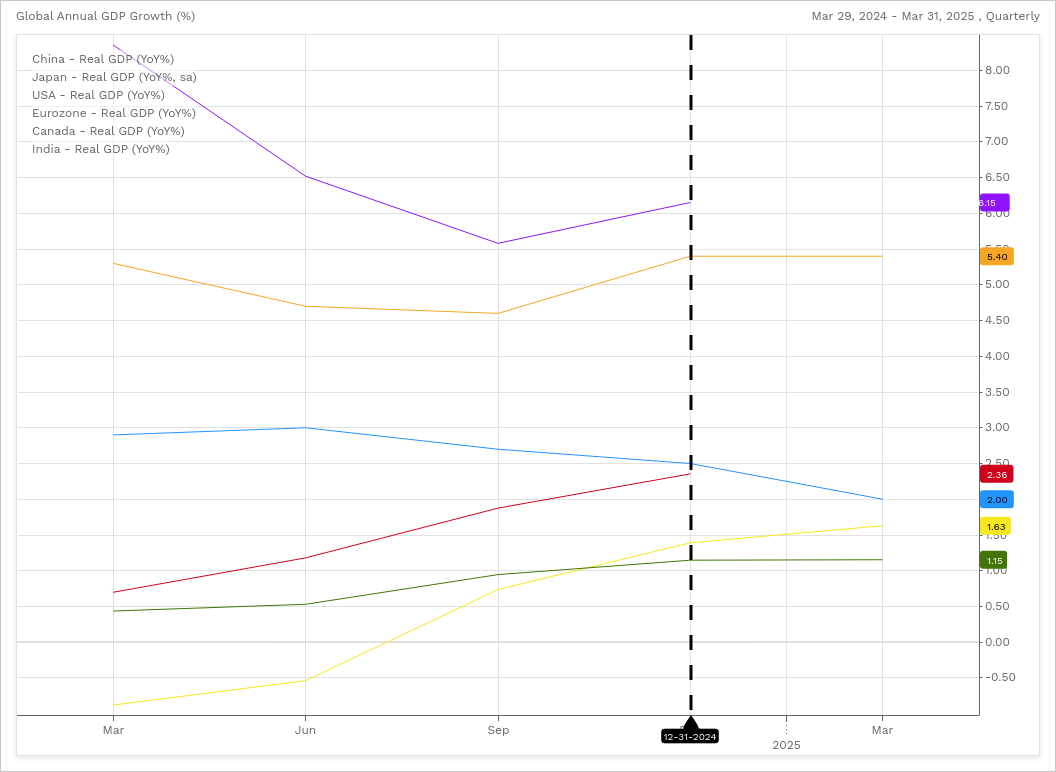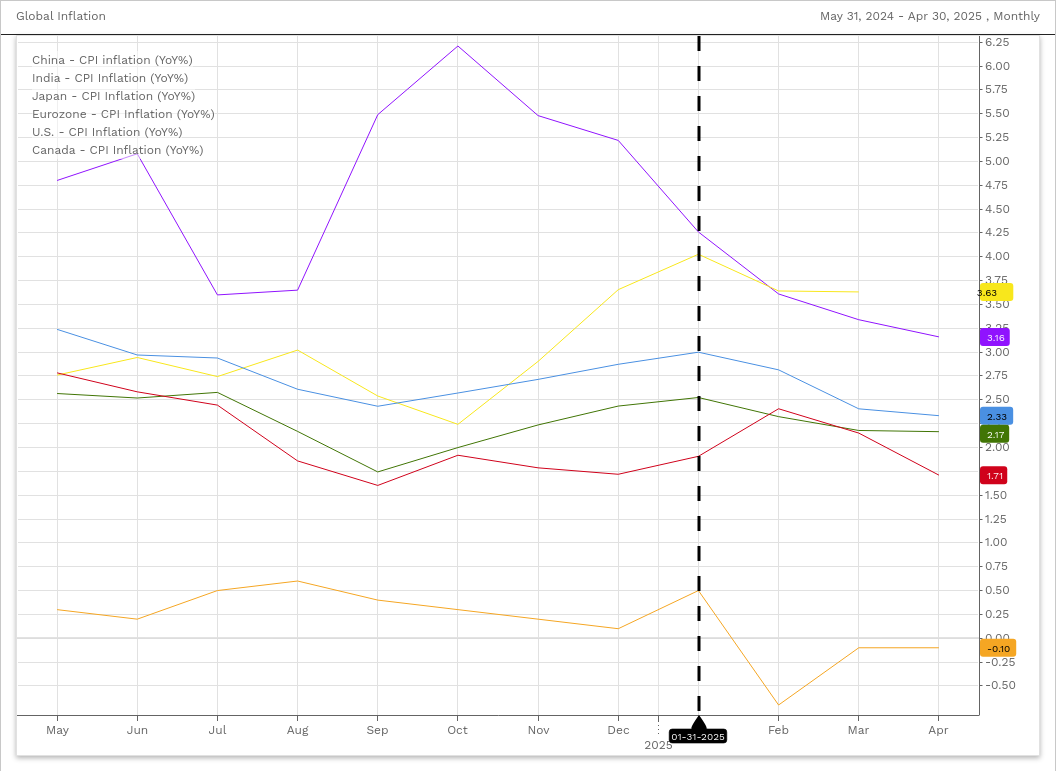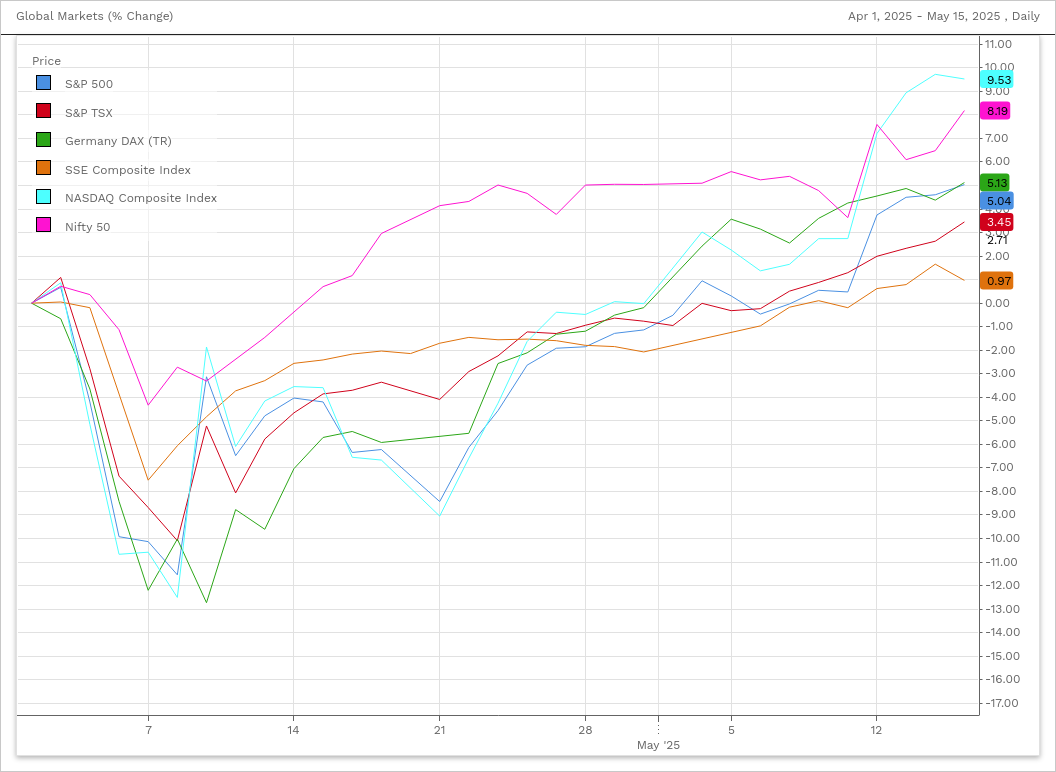| Monthly Market Analysis May 2025 |
| Economy The United States Tariff Negotiations The Trump Administration started executing emergency Executive Orders implementing new tariffs on February 1, 2025. Since then, many of the announced tariffs have either been paused, lowered, or altered. It has become quite apparent that the United States has imposed high tariffs to spur trade negotiations. All “reciprocal tariffs” implemented on April 5th, against most countries, except China, were paused on April 9th for 90 days to allow the countries to negotiate lower rates. The previously announced baseline tariff of 10% on most goods imported into the United States remains. The most extreme example of a Trump tariff implemented, and then eventually lowered, are the tariffs on Chinese imports. On February 4th, the Trump administration imposed 10% tariffs on Chinese imports. The U.S. added an additional 10% tariff on Chinese imports on March 4th, and then an additional 34% tariff on April 2nd. After a series of retaliatory tariff rate escalations by both countries the tariffs on Chinese imports into the United States stood at 145% on April 9th. By May 12th, the Trump administration rolled back the tariffs on Chinese imports from 145% to 30%. The Trump administration plans to utilize the 90-day pause to negotiate a mutually beneficial trade agreement with China. The Trump administration negotiated an interim trade agreement with the United Kingdom which maintains the 10% baseline tariff rate on UK goods but offers the U.K. some exemptions on steel and automobile tariffs. Trump Tariffs Tariffs on American imports are expected to increase the price of goods for American consumers and cut into the profits of American businesses. Nevertheless, the Trump administration has decided to utilize import tariffs to achieve their priorities: 1. Tariffs are being implemented to encourage companies to manufacture their products in the United States. The Trump administration assumes that companies will eventually produce their products in the United States to avoid tariffs. 2. The revenue from tariffs will be used to help pay for the extension of expiring tax reduction legislation, which was originally enacted in 2017 during Donald Trump’s first administration. The Congressional Budget Office estimates the cost of extending the 2017 tax cut legislation for ten additional years would be $4.6 Trillion. 3. Tariffs on U.S goods are being implemented to help eliminate the American trade deficit with other countries. The U.S. tariffs will be used as leverage to coerce other countries to lower their own tariffs and non-tariff barriers. 4. Tariffs are being used as punishment for countries that refuse to carry out American demands. Current Trump Tariffs* • 30% tariff on Chinese goods. • 10% tariff on Eurozone goods. • 25% tariff on Canadian Goods (Except goods covered under the Canada-United States-Mexico trade agreement). Canada has responded with retaliatory tariffs • 25% tariff on Mexican Goods (Except goods covered under the Canada-United States-Mexico trade agreement) • 25% tariff on all steel and aluminum imports into the United States. Canada and the European Union have responded with retaliatory tariffs. • 10% minimum tariff on all goods imported into the United States. • 25% tariff on all automobiles not assembled in the United States. *All tariff rates are now being negotiated between individual countries or trading blocks and the Trump administration. How Long will the Trump Tariffs Last? Please see below for a reminder of conditions in which Trump tariffs will be lowered or eliminated. Legal: Trump’s tariffs mostly contravene international trade law, but enforcing these laws can be a long, tedious process often with no enforceable remedies. American industries that are impacted by Trump’s tariffs often have lobby groups that can challenge the legality of the Trump tariffs in U.S. courts. The United States Congress could also intervene, since tariffs are typically under their purview, but Republicans have a majority in Congress and are unlikely to move against their party leader. Political Backlash: The negative impact of higher consumer prices in the United States and the unavailability of needed/desired goods due to retaliation by other countries may generate political backlash from U.S. consumers and businesses. China has restricted exports of critical metals to the United States. Trade Negotiations: At any time, trade negotiations between the United States and its trading partners around the world could lower or eliminate the newly announced tariffs. U.S. Midterm Elections: In November 2026, U.S. Congressional Elections may change the political environment. If American voters are unhappy with how the Trump tariffs are impacting their lives, Republicans could lose their majority in Congress. Four Year Presidential Term: In less than four years Donald Trump will complete his second and final term as the President of the United States of America. A newly elected American President could undo the Trump tariffs, if they are still in place. Global Economic Growth (Annual GDP Growth Rate) Before and After Trump Tariffs – 1 Year Chart Before Trump Tariffs: Annual GDP Growth Rate Over 12 months ending December 2024.The Canadian economy (red) grew by 2.36%, while the American economy (blue) grew by 2.5% the Eurozone economy (green) grew 1.14%, China’s economy (orange) grew 5.4%, India’s economy (purple) grew 6.15%, and Japan’s economy (yellow) grew 1.2% After Trump Tariffs (Trump tariffs started on February 4th): Annual GDP Over 12 Months ending March 2025. The U.S. economy (blue) declined from 2.5% to 2.0%. Chinese economic growth was unchanged at 5.4%. The Eurozone economic growth rate moved slightly upward from 1.14% to 1.15%. The Japanese economic growth rate (yellow) rose from 1.2% to 1.63%. – Canada and India have not yet reported their GDP growth rate for the first quarter of 2025.  Data provided by FactSet Global Annual Inflation Rates Before and After Trump Tariffs – 1 Year Chart Before Trump Tariffs: In January, the Canadian inflation rate (red) stood at 1.9%, the United States inflation rate (blue) was 3.0%, the Eurozone (green) had an inflation rate of 2.52%, China’s inflation rate (orange) was 0.5%, Japan’s inflation rate (yellow) was 4.03% and India’s inflation rate (purple) was 4.26%. After Trump Tariffs (Trump tariffs started on February 4th): The inflation rate fell for all the tracked economies. In March, Japan’s inflation rate (yellow) was 3.63%. In April, the Canadian inflation rate (red) stood at 1.71%, the United States inflation rate (blue) was 2.33%, the Eurozone inflation rate (green) was 2.17%, China’s inflation rate (orange) was -0.10%, and India’s inflation rate (purple) was 3.16%.  Data provided by FactSet United States The American economy shrunk in the first quarter of 2025. The U.S. GDP growth rate in the first quarter of 2025 declined by -0.3%, compared to a +2.4% growth rate in the fourth quarter of 2024. The Trump tariffs introduced in February may have contributed to the economic decline, but we will need additional months of data for confirmation. The U.S. Second quarter GDP growth rate data will be available at the end of July. The U.S. labour market shows no strong signs of slowing down. The U.S. economy created an additional 177,000 in April with no change in the unemployment rate, which remains at 4.2%. American consumers continue to open their wallets and purses as retail sales grew by 1.7% in March and 0.1% in April. Many retailers, including automotive dealers reported increased store traffic in March as consumers tried to beat the start of the newly announced tariffs. Surprisingly, the U.S. inflation rate fell from 2.8% to 2.3% in April, despite higher tariff rates. Oil prices fell by -16.06% and natural gas prices fell by -9.96% in April. Canada The Canadian economy saw a small rebound of 7,400 jobs in April compared to the massive loss of -32,600 in March. Yet, still, the unemployment rate increased from 6.7% to 6.9% in April. Canadian consumers resumed spending in March as retail sales increased by 0.7% compared to a -0.4% decline in February. The Canadian inflation rate is moving in the right direction as it fell from 2.3% in March to 1.7% in April. Given the uncertainty about the longevity of the Trump Tariffs on Canada, the Bank of Canada decided to leave interest rates unchanged at 2.75%, during their April meeting. Markets Global stock markets rebounded rapidly after the Trump administration paused the rollout of the reciprocal tariff program on April 9th. Over the last six weeks the U.S. Market (S&P 500) was up 5.04% while the Canadian market (S&P/TSX Composite Index) was up 3.45%. The U.S. Nasdaq Composite index which contains a high weighting of technology related stocks was up 9.53%. The German stock market (Dax 40 index) increased by 5.13%, while the Chinese market (Shanghai Composite Index) increased by 0.97% and the Indian market (Nifty 50 Index) was up 8.19%. Change in Global Stock Markets April 1 – May 15, 2025  On April 9th, when the Trump administration initiated a 90-day pause on the newly implemented Reciprocal Tariff rates excluding China, markets were rejoiceful. Then on May 12th, the de-escalation of the U.S./China tariff war provided U.S. market participants with an additional jolt of positive sentiment. U.S. tariff rates are currently higher than they were before Trump’s inauguration, but much lower than the April 5th peak tariff rates. The Trump administration is negotiating tariff rates with numerous countries and has a self-imposed 90-day deadline to complete the trade deals. Unfortunately, we are not at the end of the Trump Tariff conversation, so we can expect market volatility to return over the coming weeks. |
| 1 (Source: Bank of Canada) 2(Source: Statistics Canada) 3(Source: United States Bureau of Labour Statistics) 4(Source: United States Federal Reserve) 5(Source: United States Census Bureau) 6(Source: FactSet as of May 15, 5:00 PM) * This information has been prepared by Desmond Rubie, BCom, FCSI®, CIM®, CFP®, who is a Wealth Advisor for Rubie Wealth Management Group at iA Private Wealth. Opinions expressed in this article are those of Desmond Rubie, BCom, FCSI®, CIM®, CFP® only and do not necessarily reflect those of iA Private Wealth Inc. *IA Private Wealth Inc. is a member of the Canadian Investor Protection Fund and the Canadian Investment Regulatory Organization. iA Private Wealth is a trademark and business name under which iA Private Wealth Inc. operates.  Desmond Rubie, BCom, FCSI®, CIM®, CFP® Wealth Advisor Rubie Wealth Management Group | iA Private Wealth Insurance Advisor | iA Private Wealth Insurance* 26 Wellington Street East, 2nd Floor, Toronto, ON M5E 1S2 T: 647-429-3281 ext. 240018 Desmond.Rubie@iaprivatewealth.ca Schedule a Meeting rubiewealth.com Fellow of CSI (FCSI®) iA Private Wealth Inc. is a member of the Canadian Investor Protection Fund and the Canadian Investment Regulatory Organization. iA Private Wealth is a trademark and business name under which iA Private Wealth Inc. operates. *Insurance products are provided through iA Private Wealth Insurance, which is a trade name of PPI Management Inc. Only products and services offered through iA Private Wealth Inc. are covered by the Canadian Investor Protection Fund. |

Leave a Reply